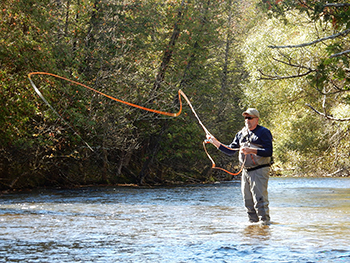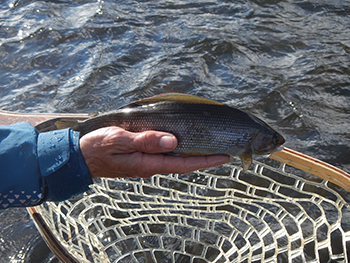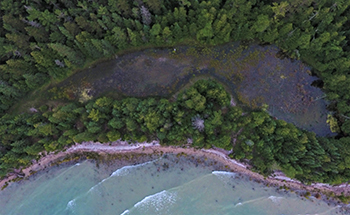Water and woods: A real estate listing fish are fans of
Exploring the link between healthy forests and clean water
By RACHEL COALE
Michigan Department of Natural Resources
Whether you’re sitting at your desk, grabbing a cup of coffee at a local café or walking in a nearby park – look around you and try to count how many things you see that are made from trees. Everything from furniture to paper to the homes we live in are made from renewable forest materials.
One that doesn’t always come to mind? Clean water.

This Great Lakes and Fresh Water Week, June 4-12, Michigan celebrates the freshwater landscape that defines our state. It’s a time to explore the connections between forests and fresh water to ensure that we’ll have healthy forests and clean water for future generations.
Trees are a vital part of that equation. They cycle water – a lot of it. In fact, a healthy, 100-foot tree can uptake 11,000 gallons of water from the soil, filter it and release it into the air in a single growing season.
Trees also increase groundwater filtration. On a landscape scale, forests are an important source of clean drinking water for millions of people in the United States, with 749 million acres of forest lands providing over half of the national water supply, according to the U.S. Forest Service. In Michigan, 20 million acres of forests, covering about half the state, clean and cycle rainwater through the watershed – about 6 trillion gallons annually – which eventually ends up in your home as clean drinking water.
“Nearly all of Michigan is part of the Great Lakes watershed, meaning that every drop of rain on the landscape and in our water systems will travel to the Great Lakes, and eventually, to the ocean,” said Emily Finnell, Great Lakes senior advisor and strategist at the Michigan Department of Environment, Great Lakes and Energy.
Trees and healthy forests not only provide Michiganders with clean water, but also help maintain habitats for fish by keeping the water clean, cool and covered.
To keep cool, fish need trees
|

Stepping barefoot onto hot pavement in the summer is a firsthand way to experience the “urban heat island effect,” in which paved concrete and asphalt surfaces heat up in the sun, raising temperatures in urban areas to scorching levels.
Planting trees can reduce this effect. The U.S. Environmental Protection Agency estimates that the shaded areas under trees can be 20-45 degrees lower than peak temperatures around them, and the water trees transpire through their leaves can further cool surrounding areas. Forested landscapes also provide more groundwater to streams, which has a cooling effect during the hot summer.
Trees along a shoreline or riverbank have the same cooling effect on water as they do on a driveway. Rivers unprotected by trees are more exposed to the sun’s rays and, as a result, are warmer than their forested counterparts.
Warmer waters may seem like a good thing to swimmers, but even the smallest increase in surface water temperature can have devastating effects on fish and wildlife.
“Water temperature is the single most important factor that determines what kind of fish can live in a stream,” said Jan-Michael Hessenauer, a fisheries research biologist with the Michigan Department of Natural Resources. “Trout species in particular require cold, stable water temperatures through the summer months and benefit greatly from forested landscapes.”
The link between healthy trees and waters
|

Trees keep waters cool, and by simply keeping soil in place, they also keep waters clean of sediment.
Most trees don’t grow a long taproot downward. Instead, roots spread outward, covering the landscape like a net. An interlocking network of roots in a forest holds soil together and prevents it from washing away in heavy rain or snowmelt.
Tree roots also increase water storage in soil, helping reduce runoff from rural farm fields and urban parking lots alike. In a contest of areas planted with trees versus those paved with asphalt, trees reduce runoff by 80% more.
Moving upward, the leaves of the forest canopy help slow down rainfall, letting it trickle down to the earth instead of splashing down hard, reducing quick overland flow that could lead to erosion.
You might ask, “Why does erosion even matter? Isn’t it just some dirt in the water?”
The answer is – not exactly.
“A small amount of sediment in the water is natural,” said DNR fisheries resource analyst Joe Nohner. “But erosion on a large scale from poorly managed sites can reduce water quality, cover fish spawning beds and damage aquatic vegetation.”
Tree roots help to retain soils that would otherwise erode into a stream and ultimately end up in a lake. When soil nutrients rise above natural levels in water, they can lead to excessive algae growth, which can be detrimental to the fish that live in the lake.
For example, cisco are known as indicator species in lakes because their health is closely tied to the temperature and quality of the water they live in. Without plants to take up nutrients before they get into the water, algae growth can explode and eventually create zones deprived of life-giving oxygen. Populations of lake cisco have been completely lost in some inland lakes – attributed to rising temperatures, declines in water quality and other environmental factors.
“Cisco are an increasingly popular fishery in their own right, but they also support trophy fisheries for walleye, northern pike and muskellunge,” Nohner said. “We anticipate losing even more populations of cisco in lakes statewide as waters continue to warm.
“Our strategy is to identify populations that we can save through water quality protection and encourage the planting and protection of forests in these areas.”
|

Similarly, the decline and local extinction of the arctic grayling – a beautiful, trout-like fish speckled in blue with a sail-like dorsal fin, which once lived in northern Michigan’s rivers – is attributed to erosion-causing, unsustainable logging practices used a century ago, habitat loss and competition. The DNR and partners are now working to restore this fish to Michigan’s waters through the Arctic Grayling Initiative.
But with a $21 billion Michigan forest products industry, is that possible?
“Modern methods of harvesting look very different than they did in the 1800s,” said DNR forest certification specialist Keith Kintigh, who works to ensure that responsible harvest and management techniques are used in state forests.
“A century ago, logging was the wild west, but today we use tools like portable bridges and crane mats to minimize environmental impacts, and require techniques like replanting or seed tree regeneration to renew the landscape after harvest. This protects the landscape and waters.”
Large and mature trees along lakes and rivers provide a constant supply of organic materials like woody debris and leaves that serve as habitat and food. When trees fall into the river, they also help to create important habitat features such as pools and small rapids.
Forests are critical to maintaining the clean, cool waters needed for grayling, trout and cisco, and keeping lakes and rivers enjoyable for all of us.
“The same things fish need to stay healthy we also need for great swimming, drinking and boating waters,” Nohner said.
Protecting forests and fresh water for the future
|

Want to help ensure healthy forests and waters in Michigan? Whether you’re more at home in the forest or at the beach, you can lend a hand. Organize an Adopt-a-Forest cleanup to remove illegal trash dumpsites in the forest that threaten fish and wildlife, or head to the shoreline to organize an Adopt-a-Beach event and pick up debris from the coast.
Closer to home, you can plant a tree to bring erosion-controlling, shade-providing and water-purifying benefits to your neighborhood. Check out a local conservation district sale or seedling nursery to find the best picks for your local area, and make sure to pin it on the DNR’s interactive tree-planting map when you do.
Tree canopy projects in Michigan watersheds and school forest planting supported by the DNR and Great Lakes Restoration Initiative are also making a difference in local communities.
If you’re a forest landowner, you can take steps to sustainably manage your forest and meet goals such as better fishing, improved wildlife habitat, sustainable timber production and more. Visit ForestsForFish.org to learn about opportunities, explore educational videos and see samples of landowner projects.
A suggested list of trees for planting near rivers and lakes includes species like yellow birch, balsam fir, peachleaf willow and sycamore that will thrive in moist conditions.
For those living on the shores of a lake or river, a good place to start is by maintaining a natural shoreline with trees and native plants instead of mowing the lawn right up to the water’s edge. This will also help deter Canada geese, natural grazers who are attracted to manicured lawns.
The Michigan Natural Shoreline Partnership shares solutions and maintains lists of suggested native plant species to plant and renew the health of the shoreline to protect lakes and rivers. A well-planted shoreline is resistant to erosion and natural water level changes and can replace the need for an engineered seawall.
As you head to the beach, pull out your fishing rod, or water your garden during Great Lakes and Fresh Water Week, think about the surprising source of some of that water – trees! Responsibly managed forests are essential for vibrant Great Lakes.
|
Check out previous Showcasing the DNR stories in our archive at Michigan.gov/DNRStories. To subscribe to upcoming Showcasing articles, sign up for free email delivery at Michigan.gov/DNR.
Note to editors: Contact: John Pepin, Showcasing the DNR series editor, 906-226-1352. Accompanying photos, other related materials and a text-only version of this story are available below for download. Caption information follows. Credit Michigan Department of Natural Resources, unless otherwise noted.
Text-only version of this story.
Angler: Trees help maintain habitats for fish by keeping the water clean, cool and covered. Pictured here, an angler fly fishing on the Platte River in the northwestern Lower Peninsula.
Cisco: Populations of cisco, fish known as an indicator species in lakes because their health is closely tied to the temperature and quality of the water they live in, have been completely lost in some inland lakes due to rising temperatures, declines in water quality and other environmental factors.
Creek: A scenic view of the forested Clark Creek, off Dead River Basin, in the Upper Peninsula’s Marquette County.
Forestry: An infographic about forestry best management practices.
Grayling: The decline and local extinction of the arctic grayling – a beautiful, trout-like fish speckled in blue with a sail-like dorsal fin, which once lived in northern Michigan’s rivers – is attributed in part to erosion-causing, unsustainable logging practices used a century ago. The Department of Natural Resources and partners are now working to restore this fish to Michigan’s waters through the Arctic Grayling Initiative.
Management (PDF): A publication titled “Michigan Forestry Best Management Practices for Soil and Water Quality.”
Manistee: An aerial image showing the headwaters of the Manistee River in the northwestern Lower Peninsula.
Shore: This aerial image shows a lake on Beaver Island, near Charlevoix in the northwestern Lower Peninsula, and the Lake Michigan shoreline.
Tree-NA: A graphic showing information about the balsam fir, part of the Department of Natural Resources’ “Tree-NA” series of educational materials about Michigan tree species. See more Tree-NA graphics on the DNR’s Tree species webpage.
|